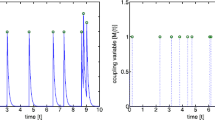Abstract
Some recent papers relate the criticality of complex systems to their maximal capacity of information processing. In the present paper, we consider high dimensional point processes, known as age-dependent Hawkes processes, which have been used to model spiking neural networks. Using mean-field approximation, the response of the network to a stimulus is computed and we provide a notion of stimulus sensitivity. It appears that the maximal sensitivity is achieved in the sub-critical regime, yet almost critical for a range of biologically relevant parameters.


Similar content being viewed by others
Notes
In fact, exponential convergence of the solution of the PDE system (1) to the unique solution of its stationary version (2) can be proved in the weak (\(\alpha <\alpha _{\mathrm{weak}}\)) and the strong (\(\alpha >\alpha _{\mathrm{strong}}\)) connectivity regime [20]. However, the result are not quantitative: \(\alpha _{\mathrm{weak}}\) and \(\alpha _{\mathrm{strong}}\) are unknown. We do not know how they compare to \(\alpha _{c}\).
It is dimensionless since \(\mu \) is a frequency and \(\delta \) a duration.
This can be proved thanks to the cluster representation of linear Hawkes processes [7] and similar results available on Galton–Watson trees.
For all \(t\ge 0, u(t,\cdot )\) remains a probability density and so it is for \(u_{\infty }\).
References
Arviv, O., Goldstein, A., Shriki, O.: Near-critical dynamics in stimulus-evoked activity of the human brain and its relation to spontaneous resting-state activity. J. Neurosci. 35(41), 13927–13942 (2015)
Bak, P., Chen, K.: Self-organized criticality. Sci. Am. 264(1), 46–53 (1991)
Beggs, J.M.: The criticality hypothesis: how local cortical networks might optimize information processing. Philos. Trans. R. Soc. Lond. A 366(1864), 329–343 (2008)
Beggs, J.M., Plenz, D.: Neuronal avalanches in neocortical circuits. J. Neurosci. 23(35), 11167–11177 (2003)
Cassandro, M., Galves, A., Löcherbach, E.: Information transmission and criticality in the contact Process. J. Stat. Phys. 168(6), 1180–1190 (2017). https://doi.org/10.1007/s10955-017-1854-3
Chevallier, J.: Mean-field limit of generalized Hawkes processes. Stoch. Process. Appl. 127(12), 3870–3912 (2017)
Hawkes, A.G.: Spectra of some self-exciting and mutually exciting point processes. Biometrika 58(1), 83–90 (1971)
Jensen, H.J.: Self-organized Criticality: Emergent Complex Behavior in Physical and Biological Systems, vol. 10. Cambridge University Press, Cambridge (1998)
Kinouchi, O., Copelli, M.: Optimal dynamical range of excitable networks at criticality. Nat. Phys. 2(5), 348–351 (2006)
Larremore, D.B., Shew, W.L., Restrepo, J.G.: Predicting criticality and dynamic range in complex networks: effects of topology. Phys. Rev. Lett. 106(5), 058101 (2011)
Malamud, B.D., Morein, G., Turcotte, D.L.: Forest fires: an example of self-organized critical behavior. Science 281(5384), 1840–1842 (1998)
Nykter, M., Price, N.D., Aldana, M., Ramsey, S.A., Kauffman, S.A., Hood, L.E., Yli-Harja, O., Shmulevich, I.: Gene expression dynamics in the macrophage exhibit criticality. Proceed. Natl. Acad. Sci. 105(6), 1897–1900 (2008)
Onaga, T., Shinomoto, S.: Emergence of event cascades in inhomogeneous networks. Sci. Rep. 6, 33321 (2016). https://doi.org/10.1038/srep33321
Reimer, I.C., Staude, B., Ehm, W., Rotter, S.: Modeling and analyzing higher-order correlations in non-poissonian spike trains. J. Neurosci. Methods 208(1), 18–33 (2012)
Reynaud-Bouret, P., Roy, E.: Some non asymptotic tail estimates for Hawkes processes. Bull. Belgian Math. Soc.-Simon Stevin 13(5), 883–896 (2007)
Shew, W.L., Plenz, D.: The functional benefits of criticality in the cortex. Neuroscientist 19(1), 88–100 (2013)
Shriki, O., Yellin, D.: Optimal information representation and criticality in an adaptive sensory recurrent neuronal network. PLoS Comput. Biol. 12(2), e1004698 (2016)
Valverde, S., Solé, R.V.: Self-organized critical traffic in parallel computer networks. Phys. A Stat. Mech. Appl. 312(3), 636–648 (2002)
Vanni, F., Luković, M., Grigolini, P.: Criticality and transmission of information in a swarm of cooperative units. Phys. Rev. Lett. 107, 078103 (2011). https://doi.org/10.1103/PhysRevLett.107.078103
Weng, Q.: General time elapsed neuron network model: well-posedness and strong connectivity regime. ArXiv e-prints (2015)
Wilting, J., Priesemann, V.: Branching into the unknown: inferring collective dynamical states from subsampled systems. arXiv preprint arXiv:1608.07035 (2016)
Acknowledgements
The author would like to thank Eva Löcherbach for inspiring discussions on this topic. This research was supported by the project Labex MME-DII (ANR11-LBX-0023-01) and mainly conducted during the stay of the author at Université de Cergy-Pontoise.
Author information
Authors and Affiliations
Corresponding author
Rights and permissions
About this article
Cite this article
Chevallier, J. Stimulus Sensitivity of a Spiking Neural Network Model. J Stat Phys 170, 800–808 (2018). https://doi.org/10.1007/s10955-017-1948-y
Received:
Accepted:
Published:
Issue Date:
DOI: https://doi.org/10.1007/s10955-017-1948-y



